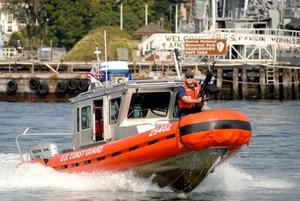Port securityRandomizing Boston Harbor security patrols
Typically, before attacking a target facility, terrorists (and criminals) watch the facility’s security routines: how often, for example, the guards patrol what section of the fence; for the facility under threat, such routines are dangerous, because they let the would-be attackers learn about gaps in security coverage, gaps than can be exploited in the attacks; USC researchers have developed a system of randomized security patrols that make it impossible for observers to predict the security patterns; LAX is already using the system, and now the Coast Guard is testing it in Boston Harbor

Coast Guard patrol in Boston Harbor // Source: wn.com
Here is a case of what during the cold war they called “spill over”: It began with work on randomizing airport security police patrol routines at Los Angeles International Airport while still maintaining the same level of protection. Now, after several other implementations, the randomizing approach to security is being tried in the waters around Boston.
Typically, before attacking a target facility, terrorists (and criminals) watch the facility’s security routines. How often, for example, the guards patrol what section of the fence. For the facility under threat, such routines are dangerous, because they let the would-be attackers learn of windows of opportunity which become available between patrols.
The new PROTECT system randomizes security. In the case of Boston Harbor, PROTECT schedules the operations of Coast Guard response vessels in a way that make it impossible for observers to predict their activities, without degrading the ability of the vessels to do their surveillance and protection work.
After months of study, the PROTECT (Port Resilience Operational / Tactical Enforcement to Combat Terrorism) system began a two-month trial around Boston Harbor on 4 April 2011.
The motivation, according to a description posted on the Web site of TEAMCORE, the University of Southern California research group that designed it, is to make best use of limited resources that “prevent full security coverage at all times, which allows adversaries to observe and exploit patterns in selective patrolling or monitoring, for example, they can plan actions avoiding existing patrols.”
PROTECT follows three airport security patrol randomization systems previously developed by TEAMCORE, a unit in the USC Viterbi School of Engineering Department of Computer Science directed by Professor Milind Tambe.
All of the three use computer applications of game theory algorithms to create schedules that fulfill the same level of law enforcement presence, but do so in such a way that even the closest observer cannot predict when or where an airport patrol team or vehicle — or in this case, a Coast Guard response vessel — will show up.
According to Craig Baldwin, a senior analyst for the Coast Guard Research and Development Center, the initial phase of the project began in September 2010, when the USC TEAMCORE group began working with Coast Guard officials to fit the ideas in the system, originally developed for airports, to the demands of patrols by Coast Guard response boats.
“The Coast Guard interest is to improve the deterrence effects of its patrol, by implementing an optimized randomized schedule for its activity,” Baldwin said.
The testing involves a force consisting of five to ten response boats, plus one coast guard cutter, deployed in the waters around Boston.
“One measure of our success would be that crews were able to maintain schedules as proscribed,” and do so without creating organizational problems,” said Baldwin. If the test is a success, he continued, the next step will be to take the model “and further evolve it in other ports.”
Baldwin said the experience of development going into testing with Tambe’s TEAMCORE group had been highly positive.
“It’s a pleasure to work with Milind’s group, ” he said. “They are not only academically astute, but able to understand the mission and fold it into their model.”
Eurekaalert reports that previous TEAMCORE applications for airport security include:
- ARMOR (Assistant for Randomized Monitoring Over Routes), used at LAX since 2007
- IRIS (IntelligentRandomization in Scheduling) a follow-on created for the Federal Air Marshalls, in use since 2009)
- GUARDS (Game-theoretic Unpredictable and Randomly Deployed Security) now being evaluated by the Transportation Security Administration
All of the USC projects are funded through the Homeland Security Center for Risk and Economic Analysis of Terrorism Events (CREATE).
